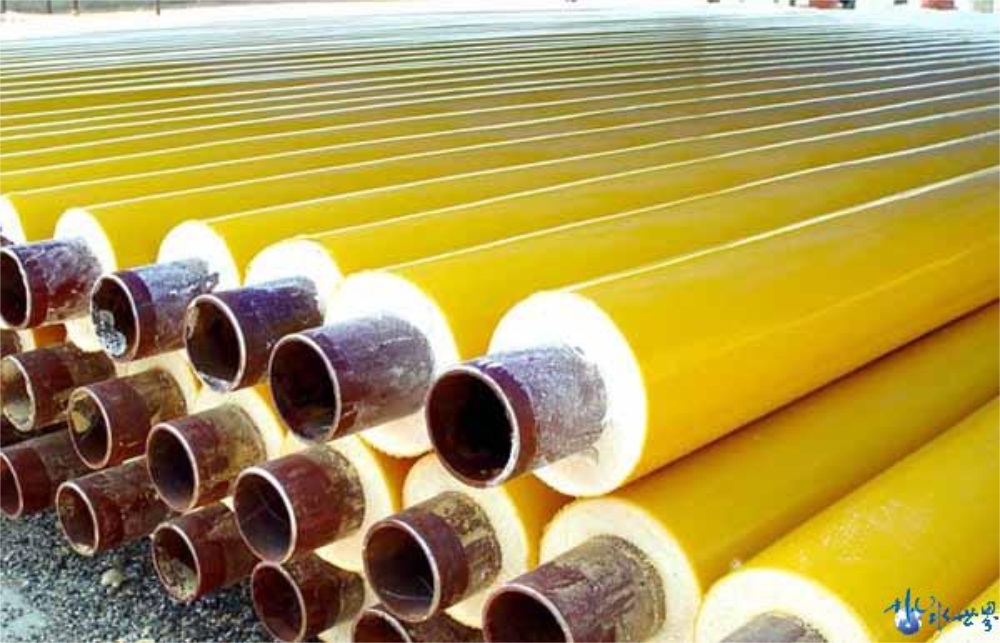高溫預(yù)制直埋保溫管從節(jié)約能源、降低造價(jià)、縮短施工周期、維護(hù)環(huán)境多方面來(lái)看,不只具有傳統(tǒng)地溝和架空敷設(shè)管道難以比較的技術(shù)和適用性能,而且具有顯著的社會(huì)效益和經(jīng)濟(jì)效益,但一個(gè)的直埋供熱管道工程還必需具備設(shè)計(jì)合理、保溫管道質(zhì)量牢靠1精心施工3個(gè)條件。由于直埋供熱技術(shù)在我國(guó)起步較晚,以上3個(gè)條件尚需不時(shí)完善。從工程理論中呈現(xiàn)的質(zhì)量問(wèn)題來(lái)看,應(yīng)在設(shè)計(jì)和施工中特別留意以下幾個(gè)問(wèn)題:
From the aspects of energy saving, cost reduction, construction period shortening and environment maintenance, the high temperature prefabricated directly buried heat preservation pipe not only has the technical and applicability performance that is difficult to compare between traditional trench and overhead pipeline laying, but also has remarkable social and economic benefits. However, a high quality directly buried heat supply pipeline project must also have reasonable design and reliable quality of heat preservation pipeline. Three construction conditions. Due to the late start of direct buried heating technology in China, the above three conditions need to be improved from time to time. From the point of view of quality problems in engineering theory, the following problems should be paid special attention to in design and construction:
高溫預(yù)制直埋保溫管
High Temperature Prefabricated Direct Buried Insulation Pipe
一、在設(shè)計(jì)和施工中,一定要真正了解供熱管道直埋敷設(shè)方式分為有補(bǔ)償直埋敷設(shè)及無(wú)補(bǔ)償直埋敷設(shè)兩種方式,的確控制兩種方式各自的工作原理,特性及其應(yīng)用場(chǎng)所,以便在設(shè)計(jì)上合理選用,施工上平安、牢靠、經(jīng)濟(jì)。
First, in the design and construction, we must really understand that the direct burial laying of heating pipelines can be divided into compensated direct burial laying and non-compensated direct burial laying. We must control the working principles, characteristics and application sites of the two methods, so as to make rational selection in design and safe, reliable and economical construction.

1 要控制概念:有補(bǔ)償直埋敷設(shè)方式,是經(jīng)過(guò)管線自然補(bǔ)償和補(bǔ)償器(如方形和波紋管補(bǔ)償器)來(lái)處理管道熱伸長(zhǎng)量的,從而使熱應(yīng)力為小;無(wú)補(bǔ)償直埋敷設(shè),簡(jiǎn)單地說(shuō)就是管道在受熱時(shí)沒(méi)有任何補(bǔ)償措施,而是靠管材自身強(qiáng)度來(lái)吸收熱應(yīng)力。
First of all, we should control the concepts: there is a compensated direct burial laying method, which is to deal with the heat elongation of pipeline by natural compensation and compensator (such as square and bellows compensator), so as to minimize the thermal stress; non-compensated direct burial laying simply means that the pipeline does not have any compensation measures when heated, but absorbs the thermal stress by the strength of the pipeline itself.
2 無(wú)補(bǔ)償敷設(shè)方式的根本原理:在裝置管道時(shí),給管道加熱到一定溫度,然后將管道焊接固定,當(dāng)管道恢復(fù)到裝置溫度時(shí)(溫度降低),管道預(yù)先接受了一定的拉應(yīng)力。當(dāng)管道通熱工作時(shí),隨著溫度的升高,管道應(yīng)力為零,當(dāng)繼續(xù)升溫時(shí),管道的壓應(yīng)力增加,當(dāng)溫度升到工作溫度時(shí),管道的壓應(yīng)力(熱應(yīng)力)仍小于許用應(yīng)力。這樣,管道能夠不用補(bǔ)償安裝而正常工作了。這種無(wú)補(bǔ)償方式應(yīng)用第四強(qiáng)度理論,施工時(shí)需求對(duì)管道預(yù)熱,施工比擬費(fèi)事,但國(guó)內(nèi)外已有大量工程理論,理論計(jì)算牢靠,能確保平安。另一種無(wú)補(bǔ)償方式是近幾年由北京煤氣熱力設(shè)計(jì)院提出的計(jì)算辦法和應(yīng)力分類采用安定性剖析,應(yīng)用第三強(qiáng)度理論。這種方式充沛發(fā)揮鋼材塑性潛力,施工便當(dāng),無(wú)需預(yù)熱。
2. The basic principle of non-compensated laying method: when installing pipeline, heating pipeline to a certain temperature first, then welding and fixing pipeline, when the pipeline restores to the installation temperature (temperature decreases), the pipeline accepts a certain tensile stress in advance. When the pipeline is heated, with the increase of temperature, the stress of the pipeline is zero. When the temperature continues to rise, the pressure stress of the pipeline increases. When the temperature rises to the working temperature, the pressure stress (thermal stress) of the pipeline is still less than the allowable stress. In this way, the pipeline can work normally without compensation installation. This non-compensatory method applies the fourth strength theory, which needs to preheat the pipeline during construction. It is difficult to compare the construction. However, there are a lot of engineering theories at home and abroad. The theoretical calculation is reliable and can ensure safety. Another non-compensatory method is the stability analysis and the third strength theory for the calculation method and stress classification proposed by Beijing Gas Thermal Design Institute of China in recent years. In this way, the plastic potential of steel can be fully developed, and the construction is convenient without preheating.
3 兩種敷設(shè)埋設(shè)深度思索不同要素。
3. Consider the different elements of two laying depths.
高溫預(yù)制直埋保溫管
High Temperature Prefabricated Direct Buried Insulation Pipe
一是當(dāng)肯定采用有補(bǔ)償直埋敷設(shè)方式時(shí),埋設(shè)深度只思索由于空中荷載的作用不會(huì)毀壞管道的穩(wěn)定便可,從經(jīng)濟(jì)、施工便當(dāng)?shù)确矫嫠妓鳌.?dāng)采用有補(bǔ)償直埋敷設(shè)方式時(shí),盡量淺埋,普通覆土厚度大于0.6米即可,且與管徑大小無(wú)關(guān)。
Firstly, when compensated direct burial is adopted, the burial depth only considers that the stability of pipeline will not be destroyed due to the action of air load, and considers from the aspects of economy and construction convenience. When compensated direct burial is adopted, shallow burial should be used as far as possible. The thickness of common overlying soil is more than 0.6 meters, and it has nothing to do with the diameter.
二是當(dāng)采用無(wú)補(bǔ)償直埋敷設(shè)方式時(shí),埋設(shè)深度要思索管道的穩(wěn)定請(qǐng)求,穩(wěn)定性當(dāng)采用不預(yù)熱的無(wú)補(bǔ)預(yù)制償高溫預(yù)制直埋保溫管的操作應(yīng)用直埋敷設(shè)管道時(shí),主要與覆土厚度有關(guān),普通比有補(bǔ)償埋得深,行,覆土厚度應(yīng)與管徑大小成正比。
Secondly, when using non-compensated direct burial method, the burial depth should consider the stability requirements of pipelines. Stability when using non-preheated non-compensated pre-made high-temperature pre-buried insulating pipes directly buried pipelines, mainly related to the thickness of overlying soil. Generally, the depth of burying with compensation is deeper, and the thickness of overlying soil should be proportional to the diameter of pipelines.
4 設(shè)計(jì)中終究采用無(wú)補(bǔ)償敷設(shè)還是有補(bǔ)償敷設(shè)方式,準(zhǔn)繩是直管道較長(zhǎng),中間分支較少,供熱介質(zhì)不超越100℃時(shí),應(yīng)優(yōu)先選用無(wú)補(bǔ)償敷設(shè)方式,否則,應(yīng)思索有補(bǔ)償敷設(shè)方式。詳細(xì)的熱網(wǎng)主干線應(yīng)采用無(wú)補(bǔ)償敷設(shè)方式,而分支庭院管網(wǎng)則應(yīng)采用有補(bǔ)償敷設(shè)方式,但目前有的設(shè)計(jì)者偏愛(ài)有補(bǔ)償敷設(shè),應(yīng)倡導(dǎo)優(yōu)化設(shè)計(jì)。
4. In the design, the non-compensatory laying or compensatory laying should be adopted. The criterion is that the straight pipeline is longer, the middle branches are fewer, and when the heating medium does not exceed 100 C, the non-compensatory laying method should be preferred. Otherwise, the compensatory laying method should be considered. Detailed heat network trunk lines should be laid without compensation, while branch courtyard pipeline networks should be laid with compensation. However, the current designers prefer to lay with compensation, and should advocate optimal design.







